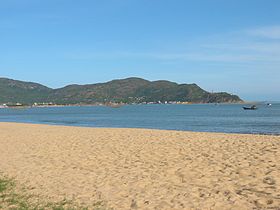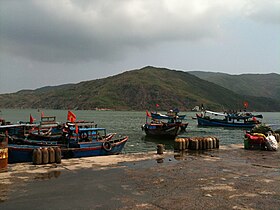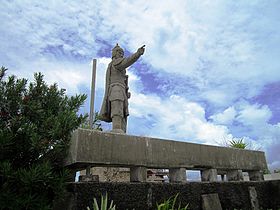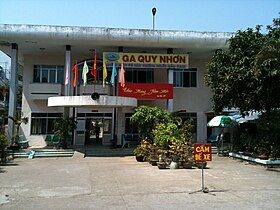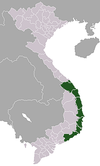Quy Nhon
You can help expand this article with text translated from the corresponding article in Vietnamese. Click [show] for important translation instructions.
|
Quy Nhon
Quy Nhơn Qui Nhon | |
|---|---|
| Thành phố Quy Nhơn | |
 Quy Nhon | |
|
UTC+7 (Indochina Time) | |
| Postal code | 55100–55199 |
| Area codes | 256 |
| License plate | 77 |
| Climate | As |
Quy Nhon (Vietnamese: Quy Nhơn Vietnamese: [kwi ɲəːŋ] ⓘ) is a coastal city in Bình Định province in central Vietnam. It is composed of 16 wards and five communes with a total of 284 km2 (110 sq mi). Quy Nhon is the capital of Bình Định province. As of 2019 its population was 457,400.[1] Historically, the commercial activities of the city focused on agriculture and fishing. In recent years, however, there has been a significant shift towards service industries and tourism. There is also a substantial manufacturing sector.
History
The origins of human settlement stretch back to the 11th-century
The town of Quy Nhon was officially founded in the late 18th century. The city is renowned as the birthplace of 18th century Vietnamese emperor
Today the city is recognized as a first class city with a geo-economic priority and an urbanized infrastructure. The government describes it as one of the three commercial and tourism centres of the central southern coastal region (with Da Nang and Nha Trang).
Geography

Quy Nhon has a varied topography, being extremely diversified with mountains and forests, hills, fields, salt marshes, plains, lagoons, lakes, rivers, shorelines, peninsulas and islands. Its coastline is 42 kilometres or 26 miles long with sandy beaches, abundant seafood resources and other natural products of economic value. Hà Thanh River flows through city.
The city has sixteen wards: Trần Hưng Đạo, Lê Lợi, Lê Hồng Phong, Trần Phú, Lý Thường Kiệt, Nguyễn Văn Cừ, Đống Đa, Thị Nại, Hải Cảng, Ngô Mây, Ghềnh Ráng, Quang Trung, Nhơn Bình, Nhơn Phú, Bùi Thị Xuân and Trần Quang Diệu. It has five villages: Nhơn Lý, Nhơn Hội, Nhơn Châu, Nhơn Hải and Phước Mỹ (which was spun off from Tuy Phước district and merged into Quy Nhon city in 2006) with a total area of 284.28 square kilometres or 109.76 square miles and a population of about 284,000 people.
Climate
Quy Nhon has a tropical monsoon climate (Am), very close to being classified as a tropical savanna climate (Köppen As), with year round very warm to hot temperatures and distinct wet and dry seasons. The city is occasionally hit by the tail-end of typhoons hitting further up the coast.[5][6]
| Climate data for Quy Nhon | |||||||||||||
|---|---|---|---|---|---|---|---|---|---|---|---|---|---|
| Month | Jan | Feb | Mar | Apr | May | Jun | Jul | Aug | Sep | Oct | Nov | Dec | Year |
| Record high °C (°F) | 34.6 (94.3) |
37.9 (100.2) |
39.8 (103.6) |
42.1 (107.8) |
41.7 (107.1) |
41.4 (106.5) |
42.1 (107.8) |
40.9 (105.6) |
39.0 (102.2) |
37.3 (99.1) |
34.6 (94.3) |
33.0 (91.4) |
42.1 (107.8) |
| Mean daily maximum °C (°F) | 26.6 (79.9) |
27.7 (81.9) |
29.3 (84.7) |
31.3 (88.3) |
33.1 (91.6) |
34.2 (93.6) |
34.3 (93.7) |
34.3 (93.7) |
32.8 (91.0) |
30.2 (86.4) |
28.3 (82.9) |
26.7 (80.1) |
30.7 (87.3) |
| Daily mean °C (°F) | 23.3 (73.9) |
24.1 (75.4) |
25.6 (78.1) |
27.6 (81.7) |
29.2 (84.6) |
30.0 (86.0) |
30.0 (86.0) |
29.9 (85.8) |
28.6 (83.5) |
26.9 (80.4) |
25.6 (78.1) |
24.0 (75.2) |
27.1 (80.8) |
| Mean daily minimum °C (°F) | 21.2 (70.2) |
21.7 (71.1) |
23.1 (73.6) |
25.0 (77.0) |
26.4 (79.5) |
27.1 (80.8) |
27.0 (80.6) |
27.0 (80.6) |
25.8 (78.4) |
24.6 (76.3) |
23.6 (74.5) |
22.1 (71.8) |
24.6 (76.3) |
| Record low °C (°F) | 15.2 (59.4) |
15.7 (60.3) |
15.8 (60.4) |
19.4 (66.9) |
19.1 (66.4) |
21.7 (71.1) |
20.6 (69.1) |
20.7 (69.3) |
20.5 (68.9) |
17.9 (64.2) |
15.0 (59.0) |
15.5 (59.9) |
15.0 (59.0) |
| Average rainfall mm (inches) | 66.8 (2.63) |
28.2 (1.11) |
33.0 (1.30) |
33.8 (1.33) |
85.2 (3.35) |
62.1 (2.44) |
44.2 (1.74) |
77.2 (3.04) |
230.6 (9.08) |
521.0 (20.51) |
464.3 (18.28) |
205.5 (8.09) |
1,851.8 (72.91) |
| Average rainy days | 13.6 | 6.6 | 5.4 | 4.7 | 8.6 | 7.8 | 7.2 | 9.5 | 15.7 | 21.4 | 21.9 | 19.1 | 141.4 |
| Average relative humidity (%)
|
80.9 | 81.6 | 82.5 | 82.2 | 79.5 | 73.5 | 71.7 | 70.8 | 77.8 | 82.5 | 83.2 | 81.8 | 79.0 |
| Mean monthly sunshine hours | 154.8 | 187.4 | 237.7 | 261.4 | 273.2 | 248.2 | 249.4 | 235.7 | 199.3 | 163.1 | 123.2 | 111.4 | 2,444.6 |
| Source 1: Vietnam Institute for Building Science and Technology[7] | |||||||||||||
| Source 2: The Yearbook of Indochina (1932-1933)[8] | |||||||||||||
Transportation

Quy Nhon is served by Vietnam Airlines, Bamboo Airways, VietJet Air and Pacific Airlines through Phu Cat Airport, with flights to Hanoi and Ho Chi Minh City.[9]
Economy

Quy Nhon is one of the main industrial centres of the
Cereals are cultivated on 2548 ha of Quy Nhon's land with an output of 13,021 tons as of 2009, just 2% of the province's total.[12] Other crops included 10,891 tons of vegetables, 2,795 tons of sugar-cane, as well as smaller amounts of coconuts, peanuts and cashew nuts.[12]
Much of the city's industry is concentrated in and around Phu Tai Industrial Park in the west of the city along National Route 1A. Quy Nhon is a major centre of garden furniture manufacturing. It has traditionally been relying on access to wood from Bình Định's forests as well as the
Other industries in Quy Nhon process agricultural and aquatic products, or produce construction materials and paper products.[11] Bidiphar is a pharmaceutical company headquartered in Quy Nhon that is an exception to the city's general focus on basic and wood processing industries. Nhơn Hội Economic Zone is central to the city's and province's industrial development plans. However, as of late 2010 it was still in the early stages of development, with few factories completed.
Quy Nhon has seen only limited foreign investment. As of 2008, thirteen foreign companies employed 1119 people in the city.[12]
Currently the economic structure of Quy Nhon is a shift towards increasing the proportion of service industries, reducing the rate of agriculture, forestry and fisheries in GDP. The shares of agriculture, forestry and fisheries – industrial and construction – services in GDP in 2006 reached 36.7%, 28% and 35.3%, respectively, while in 2005 it was at 38.4%, 26.7% and 34.9%, respectively.
The income per capita in 2018 was US$6,025 per person.
Education

Quy Nhon has two universities: Quy Nhon University and Quang Trung University. As of 2009 they had a total teaching staff of 601 and 23,383 students, 13,704 of whom were female.[12] There were 19,900 primary school students and 28,500 secondary school students.[12]
Cuisine
Quy Nhon is home to multiple domestically famous Vietnamese dishes:
- Bánh xèo tôm nhảy (jumping-shrimps fried pancake): These pancakes are made with special formulas and each restaurant has its own way of making distinguished dipping fish sauce for this dish.
- Bánh hỏi cháo lòng: The dish composes of two sub-dishes: "Bánh hỏi" (a type of rice cake in Vietnam) and "cháo lòng" (pig's internal organs porridge).
- Bún chả cá (fish-cake rice vermicelli).
- Chả ram tôm đất (shrimp spring roll).
Notable people
- Xavier Le Pichon (1937-), French geophysicist
Sister cities
 Hà Tĩnh City
Hà Tĩnh City Quảng Ngãi City
Quảng Ngãi City Attapeu
Attapeu Champasack
Champasack Saravane
Saravane Sekong
Sekong- Yongsan-gu district, Seoul
Gallery
-
Quy Nhon landscape
-
Quy Nhon city seen from above
-
Quy Nhon beach
-
Quốc học High School, Quy Nhơn
-
The boat docked at Quy Nhơn port
-
Quy Nhơn Beach
-
Statue of Quang Trung, Quy Nhơn
-
A corner of Quy Nhơn city in the early morning
-
Trần Hưng Đạo monument in Hải Minh, Quy Nhon.
-
Quy Nhon train station.
-
Fishing boats anchor at the port in Quy Nhon.
-
Quy Nhon in 2008.
Notes
References
- ^ a b "Tổng điều tra dân số và nhà ở Việt Nam năm 2009: Kết quả toàn bộ". Ban chỉ đạo Tổng điều tra dân số và nhà ở trung ương. p. 23.
- ISBN 9780321084439.
- ^ Discover Vietnam Archived April 9, 2010, at the Wayback Machine
- .
- .
- ISSN 1027-5606.
- ^ "Vietnam Institute for Building Science and Technology" (PDF).
- ^ The Yearbook of Indochina (1932-1933)
- ^ "Domestic flights in Vietnam". Indochina Travel Service (in Vietnamese and English). Dong Duong Co. 2012. Retrieved 15 October 2012.
- ^ "Vietnam Railways". Archived from the original on April 18, 2010. Retrieved November 21, 2009.
- ^ a b Atlat Dia li Viet Nam (Geographical Atlas of Vietnam). NXB Giao Duc, Hanoi: 2010
- ^ a b c d e Bình Định Statistics Office (2010): Bình Định Statistical Yearbook 2009. Statistical Publishing House, Hanoi
- ^ People's Committee Bình Định (2007): Yearbook of Information on Enterprises in Bình Định Province. Labour Publishing House, Hanoi: 162–165
External links
 Quy Nhon travel guide from Wikivoyage
Quy Nhon travel guide from Wikivoyage



